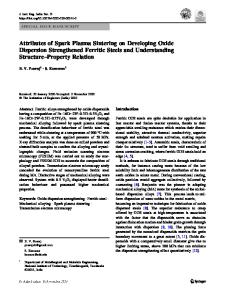High-Temperature Tensile Properties of Nano-Oxide Dispersion Strengthened Ferritic Steels Produced by Mechanical Alloyin
- PDF / 515,295 Bytes
- 5 Pages / 593.972 x 792 pts Page_size
- 27 Downloads / 358 Views
-dispersion strengthened (ODS) ferritic–martensitic steels are foreseen as highly irradiated materials for fission and fusion reactors.[1–7] To enhance creep resistance, these materials are reinforced by dispersoids within the ferritic matrix. To do so, the elaboration route includes powder metallurgy where nanometric Yttria powder and prealloyed ferritic powder are mechanically alloyed. Then, Hot Isostatic Pressing (HIP) and/or hot extrusion (HE) are classical, almost unique, steps to consolidate the materials.[1–8] However, abnormal grain growth and precipitation coarsening are often observed as these processes induce long thermo-mechanical treatments, i.e., often more than 2 hours at temperatures over 1273 K (1000 °C). Compared with HE or HIP, spark plasma sintering (SPS) spends much less time in both heating and cooling during sintering XAVIER BOULNAT, Ph.D. Student, is with the CEA, DEN, Service de Recherches Me´tallurgiques Applique´es, 91191 Gif-sur-Yvette, France, and also with the Universite´ de Lyon, INSA-Lyon, MATEIS UMR CNRS 5510, 69621 Villeurbanne, France. Contact e-mail: [email protected] DAMIEN FABREGUE, Associate Professor, and MICHEL PEREZ, Professor, are with the Universite´ de Lyon, INSA-Lyon, MATEIS UMR CNRS 5510. MARIE-HE´LE`NE MATHON, Researcher, is with the Laboratoire Le´on Brillouin, CEA-CNRS, CEA/Saclay, 91191 Gifsur-Yvette, France. YANN DE CARLAN, Researcher, is with the CEA, DEN, Service de Recherches Me´tallurgiques Applique´es. Manuscript submitted January 7, 2013. Article published online April 9, 2013 METALLURGICAL AND MATERIALS TRANSACTIONS A
process. Thus, SPS has emerged because of its ability to heat up the material very quickly, providing a powerful tool to retain the original nanostructure.[9,10] For industrial purpose, it has been used for ceramics applications and refractory materials whereas only few studies were dedicated to metallic materials.[11] Very recently, G. Ji et al. demonstrated that SPS could be used to retain the nanostructure of ODS intermetallic alloys.[12,13] However, with bending tests, they highlighted the efforts that have to be done to improve ductility despite degassing treatments. The current study aims at investigating the SPS technique as a tool for the compaction of ODS ferritic steels. Under optimal sintering conditions, semi-industrial dense pellet (0.5 kg) of ODS ferritic steel can be processed in less than 20 minutes. The associated grain structure and precipitation state have been investigated and linked to the tensile behavior at various temperatures. The powder was produced by Mechanical Alloying (MA) of a gas-atomized prealloyed steel Fe-14Cr-1W with Yttria powder (Y2O3) and TiH2 powder. TiH2 was used to add Titanium into the metallic matrix in order to refine the oxide dispersion during further processing.[14] The MA was made by high-energy attrition, dissolving the major part of Titanium, Yttrium and Oxygen in the matrix or into amorphous nanoparticles[4,15] and giving highly deformed granules with asymmetric shapes. The MA powder was then
Data Loading...











